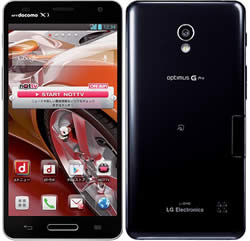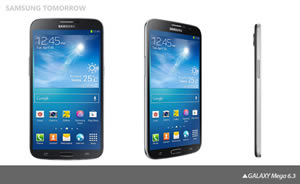Difference between LG Optimus G Pro and Samsung Galaxy Mega 6.3
Key Difference: LG Optimus G Pro has major updates to its predecessor, the LG Optimus G. The device sports a massive 5.5-inch True Full HD IPS touch screen with multi-touch capability and a pixel density of 401 ppi. Under the hood, the phone is powered by 1.7 GHz Quad-core Snapdragon 600, making it pretty fast and speedy. Samsung has now expanded its’ offerings in the phablet category by introducing the Samsung Galaxy Mega 5.8 and Samsung Galaxy Mega 6.3. The Samsung Galaxy Mega 6.3 is named such because of its 6.3 inch TFT capacitive touchscreen with a resolution of 720 x 1280 pixels. The phone is powered by a Dual-core 1.7 GHz Cortex-A15 processor with a 1.5 GB RAM.
 Since smartphones have become the ‘most important’ device in people’s lives, every smartphone company has been constantly in R&D to try and manufacture new phones with new features to capture the market. LG Electronics is one such company that has been releasing phones in various sizes, trying to boost its product portfolio to draw in customers. LG has been specially giving Samsung direct competition by releasing similar phones within the same time frame. The LG Optimus G Pro is the successor to the original LG Optimus G and resembles the Samsung Galaxy Note II in size and features. The phone has already been announced and launched in Korea, with launch date yet to be released for the rest of the world.
Since smartphones have become the ‘most important’ device in people’s lives, every smartphone company has been constantly in R&D to try and manufacture new phones with new features to capture the market. LG Electronics is one such company that has been releasing phones in various sizes, trying to boost its product portfolio to draw in customers. LG has been specially giving Samsung direct competition by releasing similar phones within the same time frame. The LG Optimus G Pro is the successor to the original LG Optimus G and resembles the Samsung Galaxy Note II in size and features. The phone has already been announced and launched in Korea, with launch date yet to be released for the rest of the world.
The LG Optimus G Pro has major updates to its predecessor, the LG Optimus G. The device sports a massive 5.5-inch True Full HD IPS touch screen with multi-touch capability and a pixel density of 401 ppi. The screen is truly amazing in viewing and the bigger screen is perfect for multi-purpose use (things people usually whip out their tablets or laptops for). The high resolution ensures crisp and sharp images, while the phone has great viewing angles. The large screen also ensures that the device is hard to hold and function with one hand. The G Pro has a sleek plastic chassis, which makes it a slippery when trying to maneuver single-handedly. However, the plastic chassis does not make the phone weak; in fact it is very resilient. LG has made it a bit easier by placing the power and the volume buttons on the right side of the device, rather than placing the power button on the top. Operating the phone requires the person holds the phone in one hand and operates using the other.
Under the hood, the phone is powered by 1.7 GHz Quad-core Snapdragon 600, making it pretty fast and speedy. The device can handle running multiple operations as well as high-res games, without major glitches. The device offers internal memory capacity of 32 GB, which can be expanded further using the microSD slot by 64 GB. The device provides 2 GB worth of RAM, decreasing the lagging effect when running too many apps. The device comes with an NFC, Infrared port, USB and Wi-Fi hotspot capability. The Infrared port ensures that the phone can be made into a remote for any supporting device, while the hot-spot allows the person to share internet with others.
The device houses a 13 MP primary camera for picture taking that supports 4208 x 3120 pixels, and a 2.1 MP secondary camera for video conferencing or calls. The camera is pretty decent in terms of taking hi-res, sharp photos, however, according to The Verge review; the camera has a tendency of washing out colors from the images. The huge viewfinder on the device is great for taking images. Both the cameras have the ability to take videos at 1080p@30fps. One pretty nifty feature on the phone is the Dual-recording feature (similar to the one on the S4), which allows the user to record videos simultaneously from both of the camera. Another feature that is boasted by the company is the Virtual Reality Panorama shot that allows the user to take images and stitch them together for 360 degree panorama shots (this feature is very similar to the Photo Shoot on the Nexus 4).
The device houses a massive Li-Po 3140 mAh battery that is removable, a must feature for many smartphone lovers. The company has yet to release the official data about the Talktime and the Stand-by time offered by the phone. LG has also added the QSlide apps and the QButton feature on the phone. The QSlide apps are widgets that allow the user to do multiple jobs on the same screen, such as take notes, see the calendar, check e-mail and can also allow the user to watch a video and text at the same time. A similar feature is available in the Note II, but it the system only allows the user to access limited apps on the phone. The QButton located on the left side of the device allows the user to access any apps on the phone by pressing the button. The device is yet to hit other shores and prices will also be announced accordingly with the release dates.
 Samsung is a major player on the world smartphone platform. It is the second most popular smartphone retailer in the world by number of units sold, after Apple. It is in fact the first most popular Android smartphone retailer in the world by number of units sold. The company’s Samsung Galaxy S3 was the first phone that gave the iPhone a real competition. Hence, effectively making the Galaxy brand, a brand to be reckoned with.
Samsung is a major player on the world smartphone platform. It is the second most popular smartphone retailer in the world by number of units sold, after Apple. It is in fact the first most popular Android smartphone retailer in the world by number of units sold. The company’s Samsung Galaxy S3 was the first phone that gave the iPhone a real competition. Hence, effectively making the Galaxy brand, a brand to be reckoned with.
Samsung is also credited with creating the ‘phablet’ category by introducing the Samsung Galaxy Note. A phablet is a cross between a phone and a tablet; it sized as a table but with all the properties of a phone. Samsung has now expanded its’ offerings in the phablet category by introducing the Samsung Galaxy Mega 5.8 and Samsung Galaxy Mega 6.3.
The Samsung Galaxy Mega 6.3 is named such because of its 6.3 inch TFT capacitive touchscreen with a resolution of 720 x 1280 pixels. The phone is powered by a Dual-core 1.7 GHz Cortex-A15 processor with a 1.5 GB RAM. The phone runs Android 4.2.2, the latest version of Android at the time of its launch. The phone also features an 8 MP primary camera and a 1.9 MP secondary front-facing camera.
In addition to the above mentioned features, the phone also boasts several features that are available on the Samsung Galaxy S4. This includes ‘Group Play’, which enables easy content sharing for up to 8 devices on the same Wi-Fi network; ‘Samsung WatchON’ that transforms the phone into an IR remote controller to connect to the home entertainment system; ‘Samsung Link’ for streaming photos, videos, notes, or music to the television, tablet or computer; ‘S Translator’ that provides instant translation, using text or voice translation on applications including email, and ChatON, which allows the user to share the phone’s screen with other users.
Furthermore, the phone also has a split screen capability that allows two or more applications to share the screen. These applications include email, messages, ‘MyFiles,’ ‘S Memo,’ ‘S Planner’, and more. The phone also has the popular ‘Air View’ feature, which allows users to preview information in emails, photos in Gallery, and speed dial contacts, before opening them. In addition, the ‘S Travel’ feature trip information, local guides and resources, etc., while the ‘Story album’ allows users to create albums of daily events, keep special moments in one place using a timeline, geo-tag information and publish digital albums in hard copy.
The information for the detailed table about the two phones has been taken from theverge.com, engadget.com, samsungmobilepress.com, samsungtomorrow.com, gdgt.com and GSMArena.com.
|
|
LG Optimus G Pro |
Samsung Galaxy Mega 6.3 |
|
Launch Date |
Q2/2013 |
May 2013 |
|
Company |
LG |
Samsung |
|
Size |
150.2 x 76.1 x 9.4 mm |
167.6 x 88 x 8 mm (6.60 x 3.46 x 0.31 in) |
|
Display |
5.5 inches True Full HD IPS Plus LCD capacitive touchscreen |
6.3 inches TFT capacitive touchscreen |
|
Screen |
1080 x 1920 pixels (~401 ppi pixel density) |
720 x 1280 pixels (~233 ppi pixel density) |
|
Protection |
N/A |
- |
|
Weight |
172 grams |
199g (7.02 oz) |
|
2G Network |
GSM 850 / 900 / 1800 / 1900 |
GSM 850 / 900 / 1800 / 1900 |
|
3G Network |
HSDPA 900 / 2100 |
HSDPA |
|
4G Network |
Depends on market availability |
LTE - GT-I9205 |
|
GUI |
LG Optimus UI |
TouchWiz UI |
|
CPU speed |
1.7 GHz Quad-core Snapdragon 600 |
Dual-core 1.7 GHz Cortex-A15 |
|
GPU |
Adreno 320 |
Mali-T604 |
|
OS |
Android v4.1.2 (Jelly Bean) |
Android OS, v4.2.2 (Jelly Bean) |
|
Chipset |
Qualcomm APQ8064T Snapdragon 600 |
Exynos 5250 |
|
RAM |
2 GB |
1.5 GB |
|
SIM Size |
microSIM |
TBA |
|
Internal Memory |
32 GB |
8/16 GB storage |
|
Expandable Memory |
Up to 64 GB |
microSD, up to 64 GB |
|
Sensors |
Accelerometer, gyro, proximity, compass |
Accelerometer, RGB light, Geomagnetic, Proximity, Gyroscope |
|
Connectivity |
2G, 3G, 4G, Wi-Fi, Bluetooth, NFC, Infrared port, DLNA, Wi-Fi hotspot, USB, USB Host. |
Wi-Fi a/b/g/n/ac, WiFi Direct BT 4.0(BLE), USB 2.0 H/S GPS+GLONASS, NFC, MHL, Infrared port |
|
Data |
GPRS, EDGE, WLAN, Bluetooth, NFC, Infrared port, USB. |
GPRS, EDGE, WLAN, Bluetooth, USB, NFC |
|
Speed |
HSDPA, HSUPA, LTE |
HSDPA, 21 Mbps; HSUPA, 5.76 Mbps; LTE, Cat3, 50 Mbps UL, 100 Mbps DL |
|
WLAN |
Wi-Fi 802.11 a/b/g/n/ac, dual-band, Wi-Fi Direct, DLNA, Wi-Fi hotspot |
Wi-Fi 802.11 a/b/g/n/ac, dual-band, Wi-Fi Direct, Wi-Fi hotspot |
|
Bluetooth |
Bluetooth v4.0 with A2DP |
Yes, v4.0 with A2DP, LE |
|
USB |
microUSB v2.0 (MHL), USB Host |
Yes, microUSB v2.0 (MHL), USB On-the-go, USB Host |
|
Primary Camera |
13 MP, 4208 x 3120 pixels |
8 MP, 3264 x 2448 pixels, autofocus, LED flash |
|
Secondary Camera |
2.1 MP, 1080p@30fps |
1.9 MP |
|
Video |
1080p@30fps Dual-video recording HDR |
Yes |
|
Camera Features |
|
|
|
Sound Enhancement |
Dolby mobile sound enhancement |
- |
|
Audio supported formats |
MP3/ WMA/ WAV/ FLAC/ eAAC+/ AC3 player |
MP3, M4A, MP4, 3GP, 3GA, WMA, OGG, OGA, AAC, FLAC |
|
Video supported formats |
MP4/ H.264/ H.263/ WMV/ DviX player |
3GP, MP4, AVI, WMV, FLV, MKV |
|
Battery Capacity |
Removable Li-Po 3140 mAh |
Li-Ion 3200 mAh battery |
|
Talktime |
No official data released |
No official data released |
|
Standby Time |
No official data released |
No official data released |
|
Available Colors |
Black, White |
White, Black |
|
Messaging |
SMS(threaded view), MMS, Email, Push Mail, IM, RSS |
SMS(threaded view), MMS, Email, Push Mail, IM, RSS |
|
Browser |
HTML5, Adobe Flash |
HTML5 |
|
Radio |
Stereo FM radio with RDS |
No |
|
GPS |
GPS with A-GPS support and GLONASS |
Yes, with A-GPS support and GLONASS |
|
Java |
Java MIDP emulator |
Yes, via Java MIDP emulator |
|
Additional Features |
|
|
Image Courtesy: engadget.com, samsungtomorrow.com









Add new comment